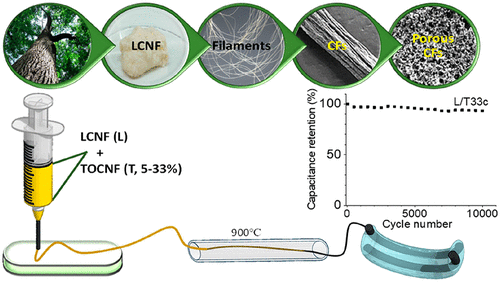当前位置:
X-MOL 学术
›
ACS Sustain. Chem. Eng.
›
论文详情
Our official English website, www.x-mol.net, welcomes your
feedback! (Note: you will need to create a separate account there.)
Mesoporous Carbon Microfibers for Electroactive Materials Derived from Lignocellulose Nanofibrils
ACS Sustainable Chemistry & Engineering ( IF 7.1 ) Pub Date : 2020-05-13 , DOI: 10.1021/acssuschemeng.0c00764 Ling Wang 1 , Maryam Borghei 1 , Amal Ishfaq 1 , Panu Lahtinen 2 , Mariko Ago 3 , Anastassios C. Papageorgiou 4 , Meri J. Lundahl 1 , Leena -Sisko Johansson 1 , Tanja Kallio 5 , Orlando J. Rojas 1, 6
ACS Sustainable Chemistry & Engineering ( IF 7.1 ) Pub Date : 2020-05-13 , DOI: 10.1021/acssuschemeng.0c00764 Ling Wang 1 , Maryam Borghei 1 , Amal Ishfaq 1 , Panu Lahtinen 2 , Mariko Ago 3 , Anastassios C. Papageorgiou 4 , Meri J. Lundahl 1 , Leena -Sisko Johansson 1 , Tanja Kallio 5 , Orlando J. Rojas 1, 6
Affiliation

|
The growing adoption of biobased materials for electronic, energy conversion, and storage devices has relied on high-grade or refined cellulosic compositions. Herein, lignocellulose nanofibrils (LCNF), obtained from simple mechanical fibrillation of wood, are proposed as a source of continuous carbon microfibers obtained by wet spinning followed by single-step carbonization at 900 °C. The high lignin content of LCNF (∼28% based on dry mass), similar to that of the original wood, allowed the synthesis of carbon microfibers with a high carbon yield (29%) and electrical conductivity (66 S cm–1). The incorporation of anionic cellulose nanofibrils (TOCNF) enhanced the spinnability and the porous morphology of the carbon microfibers, making them suitable platforms for electrochemical double layer capacitance (EDLC). The increased loading of LCNF in the spinning dope resulted in carbon microfibers of enhanced carbon yield and conductivity. Meanwhile, TOCNF influenced the pore evolution and specific surface area after carbonization, which significantly improved the electrochemical double layer capacitance. When the carbon microfibers were directly applied as fiber-shaped supercapacitors (25 F cm–3), they displayed a remarkably long-term electrochemical stability (>93% of the initial capacitance after 10 000 cycles). Solid-state symmetric fiber supercapacitors were assembled using a PVA/H2SO4 gel electrolyte and resulted in an energy and power density of 0.25 mW h cm–3 and 65.1 mW cm–3, respectively. Overall, the results indicate a green and facile route to convert wood into carbon microfibers suitable for integration in wearables and energy storage devices and for potential applications in the field of bioelectronics.
中文翻译:

木质纤维素纳米原纤衍生的用于电活性材料的介孔碳微纤维
用于电子,能量转换和存储设备的生物基材料的采用日益增长,这依赖于高级或精制的纤维素组合物。在本文中,提出了由木材的简单机械原纤化获得的木质纤维素纳米原纤维(LCNF)作为通过湿法纺丝然后在900℃下一步碳化获得的连续碳微纤维的来源。LCNF的木质素含量高(以干重计约为28%),与原始木材相似,因此可以合成具有高碳收率(29%)和导电率(66 S cm –1)的碳微纤维。)。阴离子纤维素纳米原纤维(TOCNF)的加入增强了碳微纤维的可纺性和多孔形态,使其成为电化学双层电容(EDLC)的合适平台。LCNF在纺丝原液中的负载增加,导致碳微纤维的碳收率和电导率提高。同时,TOCNF影响了碳化后的孔隙演化和比表面积,从而显着提高了电化学双层电容。当将碳微纤维直接用作纤维状超级电容器(25 F cm –3)时,它们显示出非常长的电化学稳定性(在10 000次循环后,其初始电容的> 93%)。使用PVA / H 2组装固态对称光纤超级电容器SO 4凝胶电解质产生的能量和功率密度分别为0.25 mW h cm –3和65.1 mW cm –3。总体而言,结果表明,绿色环保的路线可以将木材转化为碳微纤维,适合集成在可穿戴设备和能量存储设备中,以及在生物电子领域的潜在应用。
更新日期:2020-05-13
中文翻译:

木质纤维素纳米原纤衍生的用于电活性材料的介孔碳微纤维
用于电子,能量转换和存储设备的生物基材料的采用日益增长,这依赖于高级或精制的纤维素组合物。在本文中,提出了由木材的简单机械原纤化获得的木质纤维素纳米原纤维(LCNF)作为通过湿法纺丝然后在900℃下一步碳化获得的连续碳微纤维的来源。LCNF的木质素含量高(以干重计约为28%),与原始木材相似,因此可以合成具有高碳收率(29%)和导电率(66 S cm –1)的碳微纤维。)。阴离子纤维素纳米原纤维(TOCNF)的加入增强了碳微纤维的可纺性和多孔形态,使其成为电化学双层电容(EDLC)的合适平台。LCNF在纺丝原液中的负载增加,导致碳微纤维的碳收率和电导率提高。同时,TOCNF影响了碳化后的孔隙演化和比表面积,从而显着提高了电化学双层电容。当将碳微纤维直接用作纤维状超级电容器(25 F cm –3)时,它们显示出非常长的电化学稳定性(在10 000次循环后,其初始电容的> 93%)。使用PVA / H 2组装固态对称光纤超级电容器SO 4凝胶电解质产生的能量和功率密度分别为0.25 mW h cm –3和65.1 mW cm –3。总体而言,结果表明,绿色环保的路线可以将木材转化为碳微纤维,适合集成在可穿戴设备和能量存储设备中,以及在生物电子领域的潜在应用。











































 京公网安备 11010802027423号
京公网安备 11010802027423号